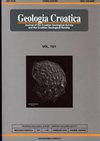阿瓦拉山地区中上新世地球动力学的地层学意义:来自Torlak Hill和Beli Potok(塞尔维亚贝尔格莱德)的新证据
IF 1.1
4区 地球科学
Q3 GEOLOGY
引用次数: 7
摘要
阿瓦拉山位于潘诺尼亚盆地(SPB)的南缘,是Dinarides和Carpathian-Balkanides隆起形态结构之间的边界地带。与潘诺尼亚盆地相似,阿瓦拉山地区近23ma的构造地层演化以裂陷前后作用和构造反转为特征。在这里,我们介绍了中新世-上新世动力学的野外调查结果,这些结果导致了同一地层单元(如巴登纪和潘诺尼纪)在相对较小的区域内的不同空间位置。这些空间关系在明显的街区结构(Torlak, Beli Potok和Avala)的背景下得到解释。托拉克山是一个由中生代岩石组成的岩心和由中中新世沉积物组成的山坡的主体构造,其地表高度可达336米。附近有晚中新世沉积充填的Beli Potok不对称海槽。托拉克地体和贝利波托克槽构造被拉科维察正断层分隔开。在断层线上的一些地方,几个地质单元垂直位移超过一百米。例如,在KGK-14井中,在地表以下100米深处观察到上中新世潘诺尼世泥灰岩。然而,在东北方向几百米以外的地方,在海拔210米的地面上观察到类似的潘诺尼期泥沼。由于上述观察到的沿块体构造的垂直运动,形成了以托拉克山和贝利波托克谷为主的复合丘陵地形。本文章由计算机程序翻译,如有差异,请以英文原文为准。
Stratigraphic implications of the Mio-Pliocene geodynamics in the area of Mt. Avala: new evidence from Torlak Hill and Beli Potok (Belgrade, Serbia)
Mt. Avala is located on the southern margin of the Pannonian basin (SPB), a border zone between the uplifted morphostructures of the Dinarides and Carpathian-Balkanides. Similar to the Pannonian basin, tectonostratigraphic evolution of the Mt. Avala area during the last 23 Ma has is characterized by syn- and post-rifting processes as well as tectonic inversion. Here, we present the results of field investigations of the Miocene‒Pliocene dynamics that led to different spatial positions of the same stratigraphic units (e.g. Badenian and Pannonian) in a relatively small area. These spatial relationships are interpreted in the context of pronounced block structures (Torlak, Beli Potok and Avala). Torlak Hill represents a horst structure with a core composed of Mesozoic rocks and hillsides composed of the Middle Miocene sediments, which are present at the surface at altitudes up to 336 metres. Nearby, there is the Beli Potok asymmetrical trough that was infilled by the late Miocene sediments. The Torlak horst and the Beli Potok trough structures are separated by the Rakovica normal fault. In some places along the fault line, several geological units are vertically displaced more than a hundred metres. For example, in borehole KGK-14, the Upper Miocene Pannonian marls are observed at a depth of 100 metres below the surface. However, only a few hundred metres away to the northeast, similar Pannonian marls are observed at the surface, at an altitude of about 210 metres. Due to the mentioned observed vertical movements along the block structures, a composite hilly relief with dominant the Torlak Hill and the Beli Potok Valley was formed.
求助全文
通过发布文献求助,成功后即可免费获取论文全文。
去求助
来源期刊

Geologia Croatica
GEOSCIENCES, MULTIDISCIPLINARY-
CiteScore
2.90
自引率
23.10%
发文量
35
审稿时长
>12 weeks
期刊介绍:
Geologia Croatica welcomes original scientific papers dealing with diverse aspects of geology and geological engineering, the history of the Earth, and the physical changes that the Earth has undergone or it is undergoing. The Journal covers a wide spectrum of geology disciplines (palaeontology, stratigraphy, mineralogy, sedimentology, petrology, geochemistry, structural geology, karstology, hydrogeology and engineering geology) including pedogenesis, petroleum geology and environmental geology.
Papers especially concerning the Pannonian Basin, Dinarides, the Adriatic/Mediterranean region, as well as notes and reviews interesting to a wider audience (e.g. review papers, book reviews, and notes) are welcome.
 求助内容:
求助内容: 应助结果提醒方式:
应助结果提醒方式:


